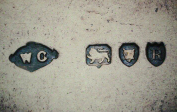Providing Education and Resources for a Better Understanding and Recognition of Precious Metal Hallmarks Worldwide
The difference between a Hallmark and a TrademarkA Hallmark is a country sanctioned, independently tested, guarantee of metal purity mark.
A Trademark is the insignia, logo, or brand of a maker that represents
the entity responsible for the claims made by the fineness mark.
Hallmarks
Refining of gold dates back thousands of years. In more recent times the mixing of other metals into pure gold and silver defined karat gold and the purity of silver. Late in the 13th century, in an effort to protect the public from misrepresented wares made of these precious metals, England introduced into law a basic marking system that would test an item's minimum purity to guarantee it is better than the silver content of the coinage in use at the time. This also eliminated the popular but unlawful practice of melting coinage to produce such wares. The first mark in use at that time was the leopard's head. With time, more marks were added identifying the assay office, year of manufacture, maker, purity and on special occasion even a commemorative mark. England was first and most systematic in their method of hallmarking from the beginning through to today. France, at the same time, also began a system of marking that over the centuries went through many modifications to the simplistic method of implied and inclusive hallmarks it uses today.
The term Hallmark came about from the English who were required to seek an assay mark for their items of precious metal before offering it for sale. The testing was conducted by wardens in regional assay offices. One of the first in England was 'The Goldsmiths Hall'. Repeated visits to the 'Hall' to get their items 'marked', after paying the required duties, resulted in the shortening of the name of the process to getting "hall-marked" and thus the word hall-mark evolved. In time, other countries followed with the practice, each having their own methodology of "Hallmarking".
As a note, the United States has not instigated a Federal law or regulation that would require the independent testing and (hall)marking of precious metal items before it could offered for sale like many European countries. The USA does require, through the National Stamping Act of 1906, and subsequent rulings and guidelines, that the purity of a precious metal item must meet the recognized precious metal standard stamped on the item within the current -0.003 purity tolerance. The fineness and accuracy of the precious metal item rests on the shoulders of the maker, manufacturer, or sponsor of the item who must also place their responsibility mark on the item near the fineness mark. A proper responsibility mark would be a registered trademark, but often is only initials of the maker or a logo that is not registered making it nearly impossible to trace unless well known. The Act and revisions continue to be worded in such a way that an item made in the USA does not need to be marked at all. Regulations are activated the moment an item is marked with a fineness. Once marked, it is required to have a responsibility mark as well. Otherwise, it is not legally marked.
Here is an example of an English made item that shows (from left to right) a
maker's mark or trademark "W C" for W. Comyns & Sons in London, the lion
passant representing the country's sterling silver standard for England
at the time, the leopard's head representing the London assay office
(where this mark was stamped) and a uniquely stylized "R" that
is a date mark that represents the year of assay ~1892-3.
Trademarks
In the United States a company or person (maker) could register, for a fee, their brand or logo with the US Trademark & Patent Office. This then would be called a registered "trademark". Trademarks are used for marking an item made of any material with the signature or logo of the maker, manufacturer or sponsor (e.g.Tiffany & Co, Mattel, Levi, etc.). In the U.S.A., companies can have their brand or logo which allows for consumer recognition and subsequence reliance in that maker for consistency in quality of product. In many countries, the maker's mark is called the responsibility mark representing the important responsibility the maker has to guarantee the quality of the item they have marked.
Here in the United States it is not required to mark an item of precious metal. If a maker chooses to place a fineness or recognized standard mark (10k, 14k, 18k, 950pt, etc) on an item, it is then mandatory that there be a responsibility mark, from the maker or sponsor to show who is responsible for guaranteeing the claimed fineness. In most other countries, a responsibility mark required as well. In countries that hallmark many but not every country requires a responsibility or sponsor's mark to be present with the hallmarks in accordance to their system of hallmarking. It is the actual hallmark that is the guarantee of accuracy in purity.
This is an example of a "trademark" and fineness mark from the famous
house of provenance "Tiffany & Co." Tiffany's, as well as other houses
of provenance, sponsor jewelry to be made and will take responsibility
for them as evidenced by marking the piece with their name or logo,
and the fineness of the metal.
The Hallmark Research Institute concentrates on hallmarks. Due to large numbers of sparsely
documented and accessibly challenged manufacturer's markings, it is difficult
to trace many maker's marks. Our services are limited in this area.
For other sites that concentrate on maker's marks, please visit our Links page.
